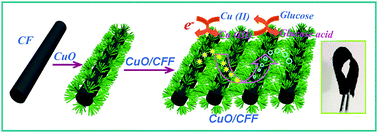Nanorod-aggregated flower-like CuO grown on a carbon fiber fabric for a super high sensitive non-enzymatic glucose sensor†
Abstract
A novel and exceptionally sensitive glucose biosensor based on nanorod-aggregated flower-like CuO grown on a carbon fiber fabric (CFF) is developed for glucose detection, which is prepared by a simple, fast and green hydrothermal method. The electron transfer resistance of the CuO/CFF electrode on the interface between the electrode and the electrolyte is as low as 12.79 Ω as evaluated by electrochemical impedance spectroscopy. A cyclic voltammetry study reveals that the CuO/CFF electrode displays an excellent electrocatalytic activity toward the direct oxidation of glucose. Besides, chronoamperometry demonstrates a high sensitivity of 6476.0 μA mM−1 cm−2 at an applied potential of 0.45 V (vs. Ag/AgCl), with a fast response time and a low detection limit of only 1.3 s and ∼0.27 μM, respectively. In addition, the glucose sensor has high reproducibility with a relative standard deviation (R.S.D.) of 1.53% over eight identically fabricated electrodes and long-term stability with a minimal sensitivity loss of ∼9.9% over a period of one month as well as excellent anti-interference ability. Importantly, the CuO–CFF composite has such good flexible characteristics and can be fabricated into flexible electrodes for application in various complicated circumstances. This work presents a new strategy to achieve highly sensitive glucose sensors with flexibility by growing glucose electroactive nanostructure materials directly on multichannels and highly conductive carbon fiber fabrics.


 Please wait while we load your content...
Please wait while we load your content...